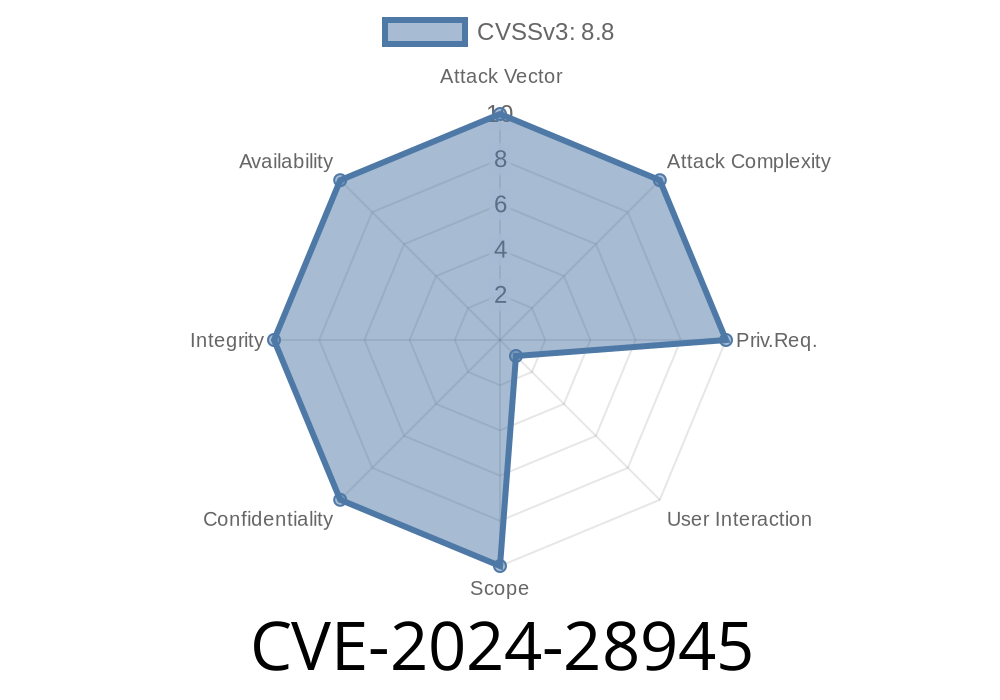In this post, we will examine the Microsoft OLE DB driver Remote Code Execution (RCE) vulnerability tracked as CVE-2024-28945. The vulnerability exists in the Microsoft SQL Server Data Provider (part of the OLE DB driver), and the successful exploitation of this issue could allow a remote attacker to execute arbitrary code on a target system, potentially gaining unauthorized access or control.
We will review the vulnerability in detail, discuss the possible exploit scenario, and share code snippets to help understand the issue better. We will also provide reference links to the original vulnerability advisory and other useful resources related to this vulnerability.
Vulnerability Details
According to the official CVE information (https://cve.mitre.org/cgi-bin/cvename.cgi?name=CVE-2024-28945), CVE-2024-28945 is defined as follows:
"Microsoft OLE DB Driver for SQL Server allows an attacker to execute arbitrary code remotely due to lack of proper input validation in the affected component. An attacker who successfully exploits this vulnerability could execute arbitrary code and take control of the affected system."
Exploit Scenario
The vulnerability exists in the way the OLE DB driver handles certain data when processing SQL queries. An attacker could exploit the vulnerability by crafting a malicious SQL query with specific data that could trigger a memory corruption. If the attacker can coerce the application using the OLE DB driver to execute the malicious SQL query, they could execute arbitrary code on the target system.
Here's a code snippet to demonstrate how a malicious SQL query might look like
DECLARE @exploit_code VARBINARY(MAX);
SET @exploit_code = [MALICIOUS_BYTE_ARRAY];
EXEC(@exploit_code);
Keep in mind that the code snippet above is just a sample and not a working exploit. The detailed exploit code for this vulnerability is not publicly available, and it's not advisable to share such information.
Defensive Measures
Microsoft released an advisory (https://portal.msrc.microsoft.com/en-us/security-guidance/advisory/CVE-2024-28945) and mitigations are available in the form of software updates for the affected OLE DB driver versions. It is highly recommended to apply these updates to resolve the vulnerability. In addition, the following best practices can help to prevent the successful exploitation of this vulnerability:
1. Remove unnecessary privileges from accounts that access the SQL Server, following the principle of least privilege. This could limit the potential impact of a successful exploit.
Use strong and unique passwords for SQL Server accounts to prevent unauthorized access.
3. Enable proper input validation and sanitization to ensure that user input cannot lead to SQL injection or similar attacks that could exploit this vulnerability.
4. Limit the network exposure of the SQL server and ensure that it only communicates with trusted systems.
5. Regularly review logs and monitor activities for potential signs of a successful exploit or intrusion.
Conclusion
CVE-2024-28945 demonstrates the importance of keeping software up-to-date and following security best practices. By analyzing and understanding the vulnerability and exploit scenario, we can better defend our systems against potential attacks. Following recommended guidelines and applying software updates promptly can help mitigate the risk associated with this and similar vulnerabilities.
Refer to the following resources for more information on this vulnerability
- Official CVE entry: https://cve.mitre.org/cgi-bin/cvename.cgi?name=CVE-2024-28945
- Microsoft Security Advisory: https://portal.msrc.microsoft.com/en-us/security-guidance/advisory/CVE-2024-28945
- Microsoft OLE DB Driver documentation: https://docs.microsoft.com/en-us/sql/connect/oledb/download-oledb-driver-for-sql-server?view=sql-server-ver15
Timeline
Published on: 04/09/2024 17:15:57 UTC
Last modified on: 04/10/2024 13:24:00 UTC
